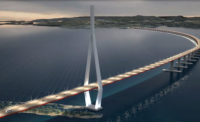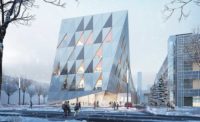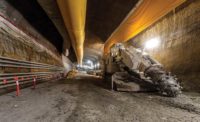The global market for design firms has been weak for the past four years. The plunge in oil prices at the end of 2014 hurt not just the petroleum market but the overall markets in nations dependent on oil for national income. Now, as the global market has begun to struggle back, a new level of uncertainty has hit the industry from nationalist and populist movements in many major markets and the looming threat of a trade war.
The uncertainty in the market can be seen in the results of ENR’s Top 225 International Design Firms survey. The Top 225 firms generated $64.59 billion in design revenue in 2017 from projects outside their home countries, up just 0.7% from $64.11 billion in 2016. This comes after five straight years of declining revenue for the Top 225. Further, the Top 225 had $79.47 billion in revenue from domestic projects in 2017, up a paltry 0.2% from $79.30 billion in 2016.
On the Top 225 International Design Firms list, firms are ranked based on design revenue from projects outside of their home countries, measuring their presence in international commerce. The ENR Top 150 Global Design Firms list measures total worldwide design revenue, regardless of the project location.
The Top 225 saw some shifts in the rankings from acquisitions. U.S.-based Jacobs’ acquisition of CH2M last year vaulted it to the No. 1 spot on the list, while Canadian SNC-Lavalin’s pickup of the U.K.’s WS Atkins pushed it up to No. 3. Wood PLC also got a boost after acquiring AMEC Foster Wheeler.
M&A Activity is continuing. Italconsult entered the U.S. market with the acquisition of New Jersey-based Boswell Engineering Inc. in April. The move helps Italconsult’s expansion “both to the American market and worldwide with a solid multinational structure already existing,” says Antonio Bevilacqua, CEO.
Many other firms are actively pursuing expansion through acquisition. “We are also talking to a few select investment banks to develop a strategic road-map plan for growth and M&A acquisitions in new markets we are targeting,” says Ammar Al Assam, CEO of Dubai-based Dewan Architects + Engineers.
Some firms say they are not for sale. Lars-Peter Søbye, CEO of Denmark’s COWI A/S, expects consolidation of design firms to continue. But because of the trust ownership nature of his firm, COWI “is not going to be the next target.” But COWI will continue to make acquisitions to support its goal of being a market leader in target sectors, he says.
Changes in the political landscape have many major design firms worried about market disruptions. The global market got its first major taste of these disruptions in 2016 when the U.K. voted to exit the European Union. Keith Howells, chairman of Mott MacDonald Group, U.K., is pleased with last year’s 10% sales increase after being “blown about” by currency fluctuations in the wake of Brexit. The resulting fall in the pound sterling provided the firm with a “strong tail wind” in its export business, he says.
The currency has stabilized, but Howells remains uncertain about Mott’s future ability to recruit staff in the European Union once Brexit ends free movement between member countries. Mott had 600-700 EU citizens on its payroll at the time of the vote. He also is concerned about the economic effects of the U.K. leaving the huge EU free trade area next March as planned. If the economy shrinks, “infrastructure [investment] might be kicked into the long grass.”
Related Links:
ENR 2018 Top 225 International Design Firms Chart
Top 225 International Design Firms 2018: Political Headwinds Worry Firms PDF
(subscription required)
Clients Are Wary
While Brexit and other protectionist policies may not be having a widespread impact yet, many design firms see their clients, public and private, hesitating before committing to projects because of the uncertainty. “Brexit and, increasingly, the global trade wars—it is hard to predict the medium- to long-term implications for business, but continuing uncertainty will lead to a slowdown in decision making,” says Liam Foley, executive director of Ireland’s PM Group.
The big concern now is the potential fallout from President Trump’s imposition of tariffs on a variety of goods from many countries, most notably on Chinese imports. “No one likes uncertainty [or] the protectionist tendencies we are currently experiencing,” says Jesper Dalsgaard, managing director for Denmark’s Ramboll Buildings. “Even though we are not directly impacted by levies on metals, our clients might be. But I fear it becomes a race to the bottom with tit-for-tat tariffs continuously being introduced, and we all end up as losers. That is my biggest concern now,” he says.
“I fear it becomes a race to the bottom with tit-for-tat tariffs continuously being introduced, and we all end up as losers. That is my biggest concern now.”
– Jesper Dalsgaard, Managing Director, Ramboll Buildings
“Escalating trade wars and economic protectionism, along with increasing restrictions on the free movement of labor, have the potential to negatively impact prospects in the international design market,” says Greg Lowe, group CEO of New Zealand’s Beca Group Ltd. He also worries that high levels of debt in a now-rising interest rate environment may impact the appetite for infrastructure investment.
Further, local and regional financial instability, especially in some regions of Latin America and the Middle East, are influencing major investment plans more than other temporary factors. Pablo Bueno Tomas, CEO of Spain’s TYPSA Group, cites several examples of such disruptions, including depressed oil prices in the Middle East, continuous changes of government or related crises in Latin American countries, and fluctuations in materials prices, all of which make financiers cautious about infrastructure investments.
A specific example of political and economic changes affecting the industry is the June 5 announcement by newly elected Malaysian Prime Minister Mahathir Mohamad that his country would scrap plans to build a high-speed railway that would have linked Kuala Lumpur with Singapore, says Andrew McNaughton, COO of France’s Systra.
An example of the types of political worries about the Latin American market comes from Mexico. The election of Andrés Manuel López Obrador earlier this month has some firms on edge after López Obrador made a campaign promise to cancel the $13-billion Mexico City International Airport project, which is underway already. While López Obrador has backtracked, his election is being seen by some firms as a political shift that potentially could hurt the market.
However, many firms are upbeat about the current market and think it will continue to grow in the near term. For COWI, 2017 “was another record year,” says Søbye of COWI A/S. Having grown sales for 14 consecutive years, “we have achieved our target when it comes to operating profit and outperformed targets when it comes to cash flow.” Søbye is optimistic about the global economy and infrastructure markets “despite the political environment which is more challenging and volatile than we have ever seen,” he says.
An Urban Future
Many design firms in both the buildings and infrastructure markets cite the accelerating trend toward urbanization as a source for work. The United Nations on May 16 released a report, 2018 Revision of World Urbanization Prospects, that found 55% of the world’s current population lives in urban areas, a proportion that is expected to increase to 68% by 2050.
Projections show that urbanization, the gradual shift in residence of the population from rural to urban areas, combined with the overall growth of the world’s population, could add another 2.5 billion people to urban areas by 2050, with close to 90% of this increase taking place in Asia and Africa, according to the report.
Many countries cited as centers for this urbanization trend are preparing a framework for dealing with a surging urban population. “The Smart City Mission launched by the Indian government is the most comprehensive and integrated mission to transform Indian cities into sustainable cities of tomorrow through infrastructure development and delivery of public services with information and communication technology,” says Vivek Sehgal, CEO of Tractebel India.
“There is an emerging demand for a new type of large-scale, high-density development in major cities in China.”
– Keith Griffiths, Chairman, Aedas
China is another example of a country taking steps to cope with the new urbanization, providing opportunities for design firms. “There is an emerging demand for a new type of large-scale, high-density development in major cities in China,” says Keith Griffiths, chairman of Hong Kong-based Aedas. “This new type of high-density, high-rise, live-work community heralds a new type of urbanity and of city building.” He says the new cities of China will be “land-frugal, connected, sustainable, integrated, smart and inclusive while using data technology to reduce energy consumption and enhance connectivity.”
Many design firms tout Asia as the most active market now. For example, the “Belt and Road Initiative (BRI) proposed by China to build synergies between cities and countries and create a super-charged engine for export trade brings many opportunities … especially in the infrastructure sector,” says Griffiths.
Many design firms are finding opportunities in China. One reason for this is China’s increasing recognition of the importance of sustainable design. Earlier this year, Singapore-based Surbana Jurong formalized a partnership with Chinese property developer China Vanke to jointly develop new industrial towns in China. “This is an urban development concept which integrates industrial developments and urban living, and aims to create sustainable cities for residents to live and work in,” says Wong Heang Fine, group CEO.
China also has a plan to build 50 large-scale international airports by 2020 to support its Belt and Road Initiative. “These airports in clusters will work in synergies with railways and roads to improve trade relations and connectivity,” says Griffiths. He says that by 2020, the Pearl River Delta potentially will be the world’s biggest market for aviation services with a projected 223 million passengers per annum.
Howells of Mott MacDonald sees good prospects in East Asia, while demand in Australia and New Zealand is “pretty strong.” Singapore is picking up, though he is disappointed that the planned high-speed railroad to Kuala Lumpur was canceled by the Malaysian government recently. The Mott team working on it has been largely redeployed, he says.
Recently back from China, Howells is targeting Chinese investments in other countries. Having built a huge manufacturing capacity, “they need projects outside China to keep that machine going,” he says. For example, Mott is advising on a Chinese-backed hydro investment in Pakistan. In India, Mott has “managed to get back into profit” after three bad years. But the Middle East remains tough for design firms, he says. Having tackled the market “from all directions” with mixed results, Mott is being more selective.
And while the petroleum market has been soft, Hyundai Engineering Co. Ltd. has been finding numerous opportunities in the Commonwealth of Independent States in Central Asia. “There is high demand in adopting international technologies in CIS region as international technologies have been applied for oil and gas, refinery and petrochemical plants,” says Sung Sang-Rok, CEO.
Middling Middle East
The Middle East has been unsteady in the past few years, with a drop in petroleum prices hurting the economies of oil-producing nations, while political tensions in countries like Iraq, Syria and Yemen, with their impact on their neighbors, has taken a toll.
Many design firms have scrambled to grow in this environment. “Even though our rapid growth indicates otherwise, during this past period we have found the [Gulf Cooperation Council] markets to be soft with an extremely competitive environment,” says Matt Squires, CEO of Bahrain-based SSH. “We have positioned ourselves well, making our offering and value proposition attractive to withstand these market pressures.” But he says this tough market has put pressure on margins for design firms.
However, Squires says the region is likely to be significantly buoyed by the level of investment being planned for Saudi Arabia as the kingdom strives to achieve the 2030 vision established by Crown Prince Mohammad bin Salman bin Abdulaziz Al Saud. “This represents a potential game changer for the region as Saudi Arabia is uniquely placed in terms of its internally generated development demand, incredible tourism potential and finally, it has the resources to employ to achieve its ambitious goals.”
More generally, Mott MacDonald has still to see positive impacts of increased oil pieces on its energy business, which account for 20% to 25% of group sales. Still suffering from the previous oil price drop, notably in the Middle East, “it will take some months or a year for big projects to come through,” Howells says.
The recent rise in oil prices may be injecting new life in the GCC markets. But some design firms say that the drop in oil prices has forced many GCC nations to refocus their energies to other areas. GCC countries now are more interested in the “need for public service architecture, urban retrofitting projects and touristic facilities,” says Birhan Emre Yazici, CEO of Turkey’s NKY.
Yazici says NKY, as a healthcare, education facilities and airport design specialist, has benefited from the move toward more social infrastructure work. He cites the new Medical City projects in the United Arab Emirates, the promotion of private funding for hospitals and education facilities in the Kingdom of Saudi Arabia and renewal of airports in the region that “reflect on our business as the greatest opportunities.”
After a difficult period in Saudi Arabia due to the oil crisis, some major business is resuming. “We just won a major contract with KACARE (King Abdullah City for Atomic and Renewable Energy) to carry out characterization and impact studies on two sites,” says Stephane Aubarbier, COO of France’s Assystem. He says the 18-month contract provides for Assystem to perform site characterization studies as well as impact studies. “It has been signed as part of the project to build Saudi Arabia’s first nuclear power plants following the announcement by the country’s government in October 2017 that it intends to add nuclear power to its energy mix.”
Going Digital
As competition and customer demand intensifies, international design firms increasingly are ramping up their technology to become more efficient. For example, Australia’s Aurecon acquired Australian Studio Magnified, a digital communications firm specializing in infrastructure, the built environment and precinct redevelopment, says Kourosh Kayvani, managing director for design, innovation and eminence.
Aurecon also has extended its digital vision to the Asian market with the Regional Centre of Excellence for Digital Engineering, based in Singapore, which launched in March. It will focus on artificial intelligence and data analytics, the internet of things, and visualization and digital collaboration, says Kayvani.
Digital technology’s “potential as a differentiator has been recognized in the Middle East, and we’re seeing ‘disruptive technologies’ being embraced at a pace other regions may struggle to match.”
– Najib Khatib, CEO, Khatib & Alami
Another firm going digital is Dutch engineer Royal HaskoningDHV. On May 1, it entered into a strategic partnership with data intelligence scale-up firm HAL24K, Amsterdam, says CEO Erik Oostwegel. The agreement includes a minority investment by Royal HaskoningDHV in the company. “HAL24K’s real-time data analytics power helps us to co-create solutions that enable our clients to optimize their operations and processes, which in turn will result in an improved experience for their end-users,” he says.
Canada’s WSP has a broad program call the Future Ready program to examine and anticipate disruptive changes and help the firm and its clients plan for them. “Future Ready is our program to see the future more clearly, and to work with clients to design for this future as well as for today’s needs,” says Alexandre L’Heureux, WSP’s CEO.
L’Heureux says the Future Ready program will help clients prepare for future realities of self-driving cars, renewables, more severe weather events and increasing alienation. “We see the future more clearly through key trends in climate change, society, technology and resources, and challenge our experts to work with our clients to advise on solutions that are both ready for today and for this future,” he says.
For some design firms, the Middle East is becoming an incubator for digital technology. “Its potential as a differentiator has been recognized in the Middle East, and we’re seeing ‘disruptive technologies’ being embraced at a pace other regions may struggle to match,” says Najib Khatib, CEO of Lebanon’s Khatib & Alami.
For example, the Dubai Future Foundation has issued the Dubai 3D Printing Strategy. Sheikh Mohammed bin Rashid Al Maktoum, ruler of Dubai, wants to make Dubai the world’s 3D printing hub and says each new building in Dubai will need to have 25% of its structure 3D-printed by 2025, says Khatib.






